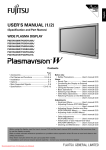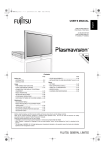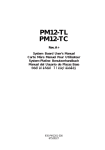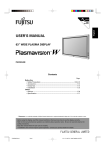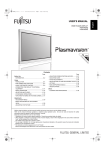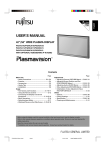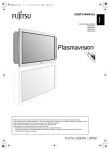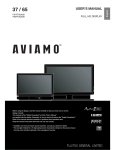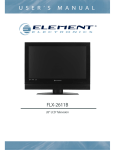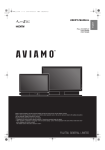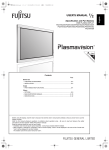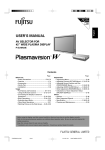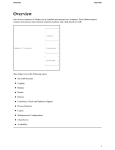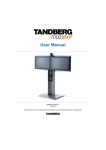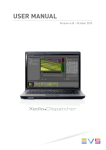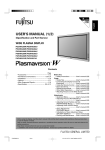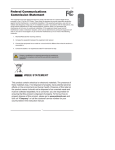Download USER`S MANUAL - HDTV Solutions
Transcript
WIDE PLASMA DISPLAY P63XHA70W Before using the display, read this manual carefully so that you know how to use the display correctly. Refer to this manual whenever questions or problems about operation arise. Be sure to read and observe the safety precautions (see the separate "Safety Precautions" manual). Keep this manual where the user can see it easily. * Installation and removal require special expertise. Consult your product dealer for details. * Even if “British English” is selected at “Language” of the On-screen display, this manual explains by “American English”. * The last digit of MODEL NO. (10 digit alphanumeric characters) indicated on the product means the body color indication alphabet or the management number. * The pictures and diagrams in this manual are meant to complement the explanations and may differ slightly from the actual things. English USER’S MANUAL CONTENTS INFORMATION ................................................................E-3 DISPLAY SECTION – FRONT .............................................E-6 DISPLAY SECTION – BOTTOM ..........................................E-7 DESCRIPTION OF INPUT TERMINALS ..............................E-8 REMOTE CONTROL ............................................................E-9 Black Level ................................................................... E-21 Detail Gradation ........................................................... E-21 3D NR ........................................................................... E-21 CODEC NR .................................................................. E-21 Image Enhance ............................................................ E-21 Color Temp. .................................................................. E-22 User Color Temp. ......................................................... E-22 Color Focus .................................................................. E-22 Progressive Scan ......................................................... E-23 PAL 3D Y/C ................................................................... E-23 USING THE REMOTE CONTROL.................................E-10 ADJUSTING SCREEN POSITION AND SIZE ...............E-24 PUTTING BATTERIES IN THE REMOTE CONTROL .......E-10 PRECAUTIONS ..................................................................E-10 EFFECTIVE RANGE FOR THE REMOTE CONTROL .......E-10 Screen Position ............................................................ E-24 Screen Size .................................................................. E-24 CHECKING ACCESSORIES ................................................E-3 INSTALLATION ...............................................................E-4 ATTACHING THE FERRITE CORES ...................................E-5 PART NAMES AND FUNCTIONS ...................................E-6 CONNECTING THE DISPLAY TO EXTERNAL EQUIPMENT ..................................................................E-11 ADJUSTING AUDIO ......................................................E-25 DVD RECORDER/PLAYER, SATELLITE TUNER .............E-11 VCR/PC ..............................................................................E-12 Treble ........................................................................... E-25 Bass ............................................................................. E-25 Balance ........................................................................ E-25 Loudness ...................................................................... E-25 BASIC OPERATIONS....................................................E-13 OTHER ADJUSTMENTS ...............................................E-26 TURNING THE POWER ON AND STAND-BY ...................E-13 RGB INPUT MODE .............................................................E-13 VIDEO INPUT MODE .........................................................E-13 ADJUSTING THE VOLUME ...............................................E-14 CONVENIENT FUNCTIONS ..............................................E-14 On-screen information ..................................................E-14 Picture Mode ................................................................E-14 Picture Memory ............................................................E-14 ADJUSTMENT .................................................................... E-26 Dot Clock ...................................................................... E-26 Clock Phase ................................................................. E-26 Clamp Position ............................................................. E-26 Auto Calibration ............................................................ E-26 ON SCREEN MENU ........................................................... E-26 On-screen Display Information (OSD) .......................... E-26 Language (Language) .................................................. E-26 Name Selection (Name Select) .................................... E-27 SETTING THE INPUT TERMINALS ................................... E-27 Video/S-video Input Terminal ...................................... E-27 D-SUB Input Terminal .................................................. E-27 OTHER SETTINGS ............................................................ E-28 Auto Off-NO SIG. ......................................................... E-28 Audio Input ................................................................... E-28 Screen Orbiter ............................................................... E-28 Direct Setting ................................................................. E-29 Code Setting.................................................................. E-29 White Screen ................................................................ E-29 Background .................................................................. E-29 Information ................................................................... E-29 WATCHING PICTURES ON THE WIDE SCREEN........E-15 SWITCHING BETWEEN SCREEN SIZES .........................E-15 SCREEN SIZE ....................................................................E-16 ASPECT RATIO ..................................................................E-16 ADJUSTMENT MENU ...................................................E-17 BASIC PROCEDURE OF ADJUSTMENT MENU .........E-18 ADJUSTING THE PICTURE..........................................E-19 Signal Contrast .............................................................E-19 Drive Contrast ...............................................................E-19 Brightness .....................................................................E-19 Color .............................................................................E-19 Tint ................................................................................E-19 Sharpness ....................................................................E-19 Ambient Sensor ............................................................E-19 Picture Mode ................................................................E-20 Precision Setting ...........................................................E-20 Picture Memory ............................................................E-20 PRECISION SETTING ........................................................E-21 E-2 INITIALIZATION OF USER ADJUSTMENT VALUE .....E-30 OPTIONS........................................................................E-31 MAIN SUPPORTED SIGNALS ......................................E-32 SPECIFICATIONS..........................................................E-33 CLEANING AND MAINTENANCE.................................E-34 English INFORMATION • Receptacle • Have the plasma display inspected and cleaned by your dealer at regular intervals. • Do not display the same picture for a long time, because part of the screen may “burn-in” and create a residual image if the same picture is displayed for an extended period of time. To prolong the life of the plasma display, we recommend the use of the “Screen Orbiter” settings. (See P. E-28) When a residual image was created, reduce the residual image by using the “White screen” settings. Note that there may also be cases when it can not be recovered completely. (See P. E-29) • When the screen size is set to “Normal” and a picture was displayed for a long time, a residual image may be created at the boundary with the part at which an image is not displayed. We recommend that you use a screen size other than “Normal”. (See P. E-15) • High-precision technology has been used in the manufacture of the plasma display panel, in which the effective pixels exceeds 99.99%. However, please be aware, that fewer than 0.01% of the pixels may be missing or remain constantly lit. • Some models are fitted with a radiator fan to prevent the plasma display’s internal temperature from rising during operation. Be careful of the air emitted by the radiator fan, as it may be hot. • Contact your dealer when causing a bad influence to the plasma display and other audio-visual equipment mutually. Français The plasma display comes with a 3-prong power plug; one prong is connected to the grounding wire. If you have only a 2-hole receptacle, you will need to have it replaced. Contact your dealer for more information. Español Deutsch Make sure that the power cord’s grounding wire is grounded. • The protective circuit, built into the display, automatically turns off the power if the display has a problem. In this case, you will see that the power indicator lamp flashes red or green. Warning If the power indicator lamp flashes red or green, this signifies that the display has developed a problem. When this happens, be sure to unplug from the receptacle to prevent fire or electric shock. Then contact your dealer. Póññêèé • It is important to install the plasma display in a location close to a receptacle, and where the emergency stop button can be easily reached. CHECKING ACCESSORIES User’s Manual Manual Power cord AA battery (2) Remote control Manual Large ferrite core A (5) Large ferrite core B Wire clamper ᣣᧄ⺆ Ё᭛ Small ferrite core (2) Safety Precautions Português • Pictures may not be displayed properly if you connect a non-standard PC to the RGB input terminal. In this case, contact your dealer for more information. Italiano You may need to move your plasma display if it produces degraded pictures or noise due to electromagnetic radiation, or if the infrared remote control does not function properly. Note • Cables for connecting the display to external equipment are not supplied. Contact your dealer for more information on these supporting products. • The pictures and diagrams in this manual are meant to complement the explanations and may differ slightly from the actual things. E-3 INSTALLATION • To prevent the plasma display’s internal components from overheating, make sure that the plasma display is installed in a well-ventilated location. • Be sure to use the optional stand, wall-mounting unit or the other mounting unit when installing the plasma display. Also, be sure that your dealer performs the installation. • See the appropriate instruction manual for additional information on the mounting hardware you select. • To prevent an accident and ensure safety in the event of an earthquake, fix the plasma display securely into the position as described below. • Use the diagram below to determine how much space is needed to ensure proper heat radiation. This is a minimum space requirement; therefore, provide at least as much space as indicated below. * Make sure that the plasma display is installed in a location where the temperature can be maintained between 0°C and 40°C (between 32°F and 104°F) * Never attempt to tilt the plasma display sideways or backward. * To prevent the power cord and other cables from being accidentally pulled, make sure that they run along the wall or through corners. * To prevent accidents and ensure safety in the event of an earthquake, secure the plasma display to prevent it from tipping over. Display Section Front Side (cm) Upper (cm) 10 Left 10 10 5 Lower E-4 Right Wall 5 English Deutsch ATTACHING THE FERRITE CORES • The ferrite cores are used to reduce noise. Attach them correctly as shown in the following illustrations. • Carefully check the terminals for position and type before making any connections. When connecting the cable to S-video input terminal and HDMI input terminal (4), attach one of these large ferrite cores A to the cable near the terminal. Español Large ferrite core A (5) HDMI Cable S-video Cable Français Ferrite core Ferrite core When connecting the power cord to the power input terminal, attach large ferrite core B near the terminal of the power cord as shown below. Italiano Large ferrite core B (1) Português Wire clamper Ferrite core (2) Pass the wire clamper through the hole. (3) Wrap the wire clamper around the power cord and fasten securely. Póññêèé (1) Attach large ferrite core B to the power cord. Small ferrite core (2) When connecting a cable to the external speaker output terminal, attach one of these ferrite cores to the cable near the terminal. Ferrite core Note • The external view is meant to be a representation of the actual unit and is not to scale; therefore, it may differ from the actual shape and size of the product. • Due to the fragile and highly precise equipment, it is very important to pack properly before transportation using only the packing materials provided. Reference See P. E-31 for more information on options. E-5 ᣣᧄ⺆ Ё᭛ Ferrite core PART NAMES AND FUNCTIONS DISPLAY SECTION – FRONT Input mode selection button Switches the input modes (Video mode and RGB mode). Volume button Adjusts the sound volume. Wide screen selection button Switches the screen over to a desired wide screen. Power indicator lamp This lamp shows the state of the power supply. Lit (red): Standby state Lit (green): Power ON state Flashing (red or green): Malfunction (Flashes differently depending on the type of malfunction.) ON/OFF button Turns the power “ON” and “OFF (standby state)”. Remote control signal receiver Receives the signals from the remote control. Ambient Sensor Detects the brightness of ambient light. It is important not to obstruct it for full functionality of the feature. Warning If the power indicator lamp flashes red or green, this signifies that the plasma display has developed a problem. When this happens, be sure to remove the power plug from the receptacle and contact your dealer. In this circumstance, leaving the plasma display power ON can result in fire or electric shock. E-6 English / I power switch If this button is pressed when the power indicator lamp is off, the indicator lamp will light. The power can be turned on and the standby mode selected by using the remote control or the control panel of the display. If this button is pressed when the power indicator lamp is lit, the indicator lamp will go out. *Power is still supplied to parts of the display even if the indicator lamp is off. Italiano Expansion terminal (EXP. PORT) Currently, this terminal is not functional and is provided to accommodate future technology enhancements. Do not connect any cable to this terminal. Français Español Deutsch DISPLAY SECTION – BOTTOM External speaker output terminal (EXT SP) Connect this terminal to the optionally available speaker. When connecting a cable, attach a ferrite core to the cable. (See P. E-5.) *See the speaker instruction manual for more information. Português RS-232C terminal (RS-232C) This terminal is provided for you to control the display from the PC. Connect it to the RS-232C terminal on the PC. HDMI input terminal (VIDEO8 INPUT/HDMI) HDMI input terminal (VIDEO7 INPUT/HDMI) HDMI input terminal (VIDEO6 INPUT/HDMI) Póññêèé HDMI input terminal (VIDEO5 INPUT/HDMI) Connect this terminal to the HDMI output terminal of DVD recorder/player or other video equipment. If the HDMI output is connected, an Audio signal cable does not need to be connected. When connecting a cable, attach a ferrite core to the cable. (See P. E-5.) RGB1 input terminal (RGB1 INPUT/mD-sub) Connect this terminal to the output terminal of a PC, set-top box, game, etc. Component Video input terminal (VIDEO3 INPUT) Component Video input terminal (VIDEO4 INPUT) Connect this terminal to the Component Video output terminal of DVD recorder/player or satellite receiver. Video input terminal (VIDEO1 INPUT) Connect this terminal to the video output terminal of your VCR. " S-video input terminal (VIDEO2 INPUT) Connect this terminal to the S-video output terminal of your VCR. When connecting a cable, attach a ferrite core to the cable. (See P. E-5.) Ё᭛ # Audio3 input terminal (AUDIO3 INPUT) $ Audio2 input terminal (AUDIO2 INPUT) % Audio1 input terminal (AUDIO1 INPUT) Connect this terminal to the audio output terminal of VCR or PC, etc. ᣣᧄ⺆ & Power input terminal Connect this terminal to the power cord supplied with the plasma display. When connecting the cord, attach a ferrite core to the cord. (See P. E-5) Note • The pictures and diagrams in this manual are meant to complement the explanations and may differ slightly from the actual things. E-7 PART NAMES AND FUNCTIONS (CONTINUED) The table below shows the settings of Audio inputs. (Factory setting) * For changing of Audio input settings, see Audio Input on P. E-28. Video input RGB1(mD-sub) Video1(Video) Video2(S-video) Video3(Component Video) Video4(Component Video) Video5(HDMI) Video6(HDMI) Video7(HDMI) Video8(HDMI) Audio input Audio1 Audio2 Audio2 Audio3 Audio3 Audio4(HDMI) Audio5(HDMI) Audio6(HDMI) Audio7(HDMI) DESCRIPTION OF INPUT TERMINALS mD-sub input terminal (RGB1 INPUT/mD-sub) Pin No. Pin No. 9 Input signal Red 2 Green 10 Ground 3 Blue 11 — 4 — 12 — 5 Ground 13 Horizontal synchronization 6 Ground 14 Vertical synchronization 7 Ground 15 — 8 Ground Frame Ground RS-232C terminal (RS-232C) HDMI input terminal (VIDEO5-8 INPUT/HDMI) Input signal 1 — Pin No. Signal 1 DCD (Data Carrier Detect) 2 RD (Received Data) 3 TD (Transmit Data) 4 DTR (Data Terminal ready) 5 GND (Ground) 6 DSR (Data Set Ready) 7 RTS (Request To send) 8 CTS (Clear To Send) 9 RI (Ring Indication) Pin No. Input signal Pin No. Input signal 1 T.M.D.S. Data2+ 11 T.M.D.S. Clock Shield 2 T.M.D.S. Data2 Shield 12 T.M.D.S. Clock– 3 T.M.D.S. Data2– 13 CEC 4 T.M.D.S. Data1+ 14 Reserve 5 T.M.D.S. Data1 Shield 15 DDC Clock 6 T.M.D.S. Data1– 16 DDC Data 7 T.M.D.S. Data0+ 17 Ground (for +5V) 8 T.M.D.S. Data0 Shield 18 +5V Power 9 T.M.D.S. Data0– 19 Hot Plug Detect 10 T.M.D.S. Clock+ Frame FG TRADEMARK INFOMATION HDMI , the HDMI logo and High-Definition Multimedia Interface are trademarks or registered trademarks of HDMI licensing LLC. E-8 English For details, see page Î Deutsch REMOTE CONTROL (POWER button) Î E-13 - (MUTE button) Î E-14 Press to temporarily mute the audio. To return the audio to normal, press this button once again, or press the 1 or 2. (Video input mode selector button) Î E-13 Español Switches between Power On and Standby. Press to select VIDEO1 - 8. (RGB input mode selector button) Î E-13 Français Press to select RGB1. (WIDE button) Î E-15 Press to switch the screen size. 㨪 (Number buttons) Î E-13 Italiano Use to select the Video mode. H or I (INPUT buttons) Português Press to switch the Video or RGB mode. ; (MENU button) Î E-18–E-30 Press to display or hide the menu screen. Use for picture or audio adjustment. < (ENTER button) Î E-18–E-30 Póññêèé Press to confirm the setting you made with the adjustment buttons. C, D, E, or F (Adjustment buttons) Î E-18–E-30 Press to select the adjustment item or adjust the value in the menu screen. 3 (DISPLAY button) Î E-14 Press to display the input mode and screen size status. The status is displayed for about five seconds. 4 (PICTURE MODE button) Î E-14 Press to switch the Picture Mode. " 5 (PICTURE MEMORY button) Î E-14 # Ё᭛ Press to recall a Picture Memory. 1 or 2 (Volume adjustment buttons) Î E-14 ᣣᧄ⺆ Press to adjust the volume. Note • Some functions are not available depending on the state or condition of use. E-9 USING THE REMOTE CONTROL PUTTING BATTERIES IN THE REMOTE CONTROL (1) To remove the cover, slide it outwards while pressing it down. (2) Place two AA batteries in the remote control. Make sure that the batteries are properly oriented. (3) Close the cover until it snaps into place. PRECAUTIONS To prevent malfunction, do not apply any form of severe shock to the remote control. To prevent malfunction or deformation, do not allow the remote control to become wet and keep it away from hot surfaces or heating equipment. Do not clean the remote control using a cloth dampened in a volatile solvent, such as benzene or thinner. EFFECTIVE RANGE FOR THE REMOTE CONTROL When using the remote control, be sure to point it directly at the plasma display's signal receiver. Make sure that there are no obstacles between the remote control and the plasma display's signal receiver. Upper Lower Display – front Display – side Right Left 5 m (Front) CAUTION It is very important to use replacement batteries of the same type as the originally used. Do not use rechargeable batteries (Ni-Cd, etc.). When disposing of used batteries, please comply with governmental regulations or environmental public institution’s rules that apply in your country/ area. Note • The remote control will not function properly if the batteries are dead. Be sure to replace them as needed. • The remote control may not function properly if a high-frequency fluorescent lamp or the like is used. In this case, move the lamp or use the remote control from a different position. E-10 English CONNECTING THE DISPLAY TO EXTERNAL EQUIPMENT • Connect the video signal cable to the HDMI input terminal, component video input terminal, S-video input terminal, or the video input terminal. Español • If the equipment to be connected is equipped with HDMI output terminal and component video output terminal, it is recommended to connect to one side or the other. (If the HDMI output is connected, an Audio signal cable does not need to be connected.) Français Antenna (commercially available product) To component video outputs To video output To audio outputs To video input To S-video input To component video inputs Português To audio inputs Italiano To S-video output Deutsch DVD RECORDER/PLAYER, SATELLITE TUNER To HDMI input Póññêèé Display bottom ᣣᧄ⺆ Ё᭛ To HDMI output E-11 CONNECTING THE DISPLAY TO EXTERNAL EQUIPMENT (CONTINUED) VCR/PC • Connect the video signal cable to either the S-video input terminal or the video input terminal. • If the unit to be connected is equipped with S-video output terminal, it is recommended to connect to the S-video terminal. • As the cable for connecting a PC differs with the PC model, please consult your dealer for information on the right cable to purchase. To audio output To audio inputs To RGB output (mD-sub) To video output To S-video output To audio outputs To RGB input (mD-sub) To audio inputs To S-video input To video input Display bottom Note • • • • Be sure to turn off power of the plasma display and external equipment before making any connections. Loose connectors can result in picture or color problems. Make sure that all connectors are securely inserted into their terminals. Also refer to the instructions for the component to be connected. When inputting audio, connect to the terminals corresponding to the used video input or RGB input. E-12 English BASIC OPERATIONS Press/I to the left at the bottom of the display to the ONstate. The power lamp lights up. on the remote control. Español Press The color of the power lamp changes from “Red” to “Green”. Press or . Select the video mode to input. Press when the power is ON. The color of the power lamp changes from “Green” to “Red” and the the power turns “OFF (Standby state)”. Français * You can also use the buttons on the display’s control panel to perform these steps. 1 2 3 4 Deutsch TURNING THE POWER ON AND STAND-BY 1 Press Italiano RGB INPUT MODE to select the input mode. You can select RGB1. Português • RGB1: mD-sub * For selection of the input terminal, see “SETTING THE INPUT TERMINALS” on P. E-27. Póññêèé RGB1 mode VIDEO INPUT MODE Press to select the input mode. The video modes corresponding to each input terminal are as follows. • VIDEO1: Video Video1 mode • VIDEO2: S-video • VIDEO3: Component Video • VIDEO4: Component Video • VIDEO5: HDMI • VIDEO6: HDMI • VIDEO7: HDMI • VIDEO8: HDMI * For selection of the input terminal, see “SETTING THE INPUT TERMINALS” on P. E-27. Note • Some functions are not available depending on the state or condition of use. E-13 Ё᭛ You can select from VIDEO1 mode to VIDEO8 mode. You can also change VIDEO mode by pressing – during “Video” indication on the screen by pressing . ᣣᧄ⺆ 1 BASIC OPERATIONS (Continued) ADJUSTING THE VOLUME Adjusting the volume Press 1 to increase the volume. Press 2 to reduce the volume. * Note that the volume level remains stored even when you turn OFF the power. Muting the audio Press -. When the volume adjustment button is pressed The audio is removed. Press again to restore the audio to the original level. * The mute mode can also be released by pressing the volume buttons. * You can also use the buttons on the display’s control panel to perform these steps. CONVENIENT FUNCTIONS On-screen information Press 3. The mode is indicated on the screen for 5 seconds. Picture Mode Press 4. This button can be used to switch the picture mode. In the picture mode, you can switch between the set status and the fine mode. * For the picture mode settings, see “Picture Mode (P. E-20)”. Picture Memory Press 5. This button can be used to recall the settings of the picture memories 1 – 8. Each time this button is pressed, the setting changes as follows. $Memory1$Memory2$Memory3$Memory4$Memory5$Memory6$ Memory7$Memory8$ * For the picture memory settings, see “Picture Memory (P. E-20)”. Note • Some functions are not available depending on the state or condition of use. E-14 English WATCHING PICTURES ON THE WIDE SCREEN . The currently selected mode will appear. Press Size. Español 2 Press to select a desired Screen Normal mode Each time you press , a different Screen Size appears. The sequences used are as follows: Français 1 Deutsch SWITCHING BETWEEN SCREEN SIZES • Video mode (SD signal) $Normal$Wide1$Wide2$ Zoom1$Zoom2$ • Video mode (HD signal) * You can also use the buttons on the display’s control panel to perform these steps. • RGB mode Italiano $Wide1$Wide2$ Wide1 mode $Normal$Wide$Zoom$ Póññêèé Português * Depending on the type of signal, some aspects may not be selected. E-15 ᣣᧄ⺆ • When the WIDE mode is set to “Normal”, and pictures are shown for an extended time, a residual image or “burn-in” may be created. The burn-in may occur at the boundary where the left and right borders of the picture meet the vertical bars. To reduce the chance of “burn-in” when watching in the “Normal”, we recommend you set the “Background” to “Light Gray”. (See P. E-29) • When a residual image was created, it is reduced by using the “White Screen” settings. Note that there may also be cases when it can not be recovered completely. (See P. E-29) • A variety of Screen Sizes are available with this display. Remember that if you select a mode with an aspect ratio (ratio of frame width to frame height) different from that of the TV program or video media, the pictures will appear differently than if you had selected a mode having the same aspect ratio. • Showing a movie or similar premium event at a different aspect ratio from its original one at any event site, restaurant, or bar for profit-making purposes or for a public audience may constitute a copyright infringement. For films, try to select a mode having the same aspect ratio as the original picture; this enables the director’s original intentions to be preserved. • See P. E-24 for how to adjust the picture size and position. Ё᭛ Note WATCHING PICTURES ON THE WIDE SCREEN (Continued) SCREEN SIZE Normal Displays pictures of normal size (i.e., a 4:3 aspect ratio). Wide1 • Video mode (SD signal) Displays natural-looking pictures of normal size on the wide screen. • Video mode (HD signal) Picture of Normal size Wide1 Vertically extended picture Wide2 Picture of Normal size Wide2 Horizontally extended picture Zoom1 Horizontally extended picture with caption Zoom2 Displays wide size (16:9 aspect ratio) pictures. Wide2 • Video mode (SD signal) Ideal for displaying vertically extended pictures such as anamorphic (squeezed widescreen) pictures. • Video mode (HD signal) An HD signal picture displayed in normal size is displayed as wide screen with minor image stretching. Wide Displays normal size picture as wide screen. Zoom1/Zoom Enlarges horizontally extended pictures equally in all directions to maintain the aspect ratio constant. Zoom2 Reduces the height of horizontally extended pictures with captions, without eliminating the caption. Only the height of pictures is reduced, not the height of the caption. (Captions may not be easy to read, however, depending on the picture.) * The Zoom mode display method may be different, depending on the input signal. ASPECT RATIO The following aspect ratios are available. VHF/UHF broadcasting, BS broadcasting HDTV broadcasting 4:3 aspect ratio 16:9 aspect ratio Vista Vision size 1.85:1 aspect ratio Cinema Scope size 2.35:1 aspect ratio Note You may find dark areas on top and at the bottom of the screen if you select one of the Zoom modes for media while using the Vista Vision or Cinema Scope size i.e., the sizes used frequently for picture software. • Some functions are not available depending on the state or condition of use. E-16 English ADJUSTMENT MENU (E-19) Drive Contrast (E-19) Brightness (E-19) Color (E-19) Tint (E-19) Sharpness (E-19) Ambient Sensor (E-19) Picture Mode (E-20) Precision Setting (E-20) Picture Memory Black Level Español Signal Contrast (E-21) Detail Gradation (E-21) 3D NR (E-21) CODEC NR (E-21) Image Enhance (E-21) Color Temp. (E-22) User Color Temp (E-22) Color Focus (E-22) Progressive Scan (E-23) PAL 3D Y/C (E-23) Dot Clock (E-26) Clock Phase (E-26) Clamp Position (E-26) Image identify (E-21) Chroma Transient (E-21) 24 Frame Mode (E-23) 30 Frame Mode (E-23) Jaggies Filter (E-23) Motion Setting (E-23) (E-20) (E-24) Position (E-24) Size (E-24) Português Default POSITION/SIZE (E-25) (E-25) Balance (E-25) Loudness (E-25) Adjustment (E-26) On Screen Menu Input Terminal Others FACTORY DEFAULT (E-26) (E-27) (E-28) Auto Calibration (E-26) OSD (E-26) Language (E-26) Name Select (E-27) Video Input (E-27) S-video Input (E-27) D-SUB Input (E-27) Auto Off-NO SIG. (E-28) Audio Input (E-28) Screen Orbiter (E-28) Direct Setting (E-29) Code Setting (E-29) White Screen (E-29) Background (E-29) Information (E-29) Ё᭛ (E-26) Treble Bass ᣣᧄ⺆ FEATURES (E-25) Póññêèé Default AUDIO Français (E-18) Italiano PICTURE MENU Deutsch The numbers in parentheses ( ) indicate the reference page numbers. (E-30) Note • Some functions are not available depending on the state or condition of use. E-17 BASIC PROCEDURE OF ADJUSTMENT MENU • Shown below is the basic procedure used to change the options on the ADJUSTMENT MENU. (Ex.: Adjusting tint setting (Tint)) Selecting the adjustment mode for adjustment or setting. (The items to be adjusted or set are stored for each adjustment mode.) 1 2 Press ;. The main menu screen will appear. Press E or F to select “PICTURE”. Each time you press E or F, one of the available menus appears in the following sequence: PICTURE < POSITION/SIZE < AUDIO < FEATURES < FACTORY DEFAULT The PICTURE Menu screen will appear. 3 4 Press C or D to select “Tint”. Press <. “PICTURE” selected in the main menu screen The “Tint” adjustment screen will appear. “Tint” selected in the PICTURE Menu screen 5 6 7 Press E or F to change tint values. F: More greenish colors E: More purplish colors Press < to store. Press ; when you finish. “Tint” adjustment screen * Repeat steps 3, 4, 5 and 6 when you wish to make changes to other options. * Select “Default” and press <. The PICTURE items are changed back to the default settings available when the plasma display was purchased. * Press ; to halt the operation in progress. Note • On-screen information disappears if you do not take any action for about 60 seconds. • Some functions are not available depending on the state or condition of use. • The adjustment range varies with the display signal. You can adjust the display quality to the value you want within the adjustable range. E-18 English ADJUSTING THE PICTURE Deutsch • Picture-related items can be set and adjusted in the Picture Adjustment Screen. See BASIC PROCEDURES OF ADJUSTMENT MENU on P. E-18 for the basic procedures. Signal Contrast Press F to increase the input signal contrast. Press E to reduce the input signal contrast. Español Press < to store. Drive Contrast Press F to raise the display’s luminance level, and increase the contrast. Press E to lower the display’s luminance level, and reduce the contrast. Français Press < to store. * If Ambient Sensor is ON, the change made by this adjustment may be difficult to be recognized in too bright or dark a place. Brightness Press F to increase the brightness. Press E to reduce the brightness. Italiano Press < to store. Color Press F to darken the color. Português Press E to lighten the color. Press < to store. Tint Press F to change the tint to a more greenish color. Press E to change the tint to a more purplish color. Póññêèé Press < to store. Sharpness Press F to sharpen the Sharpness. Press E to soften the Sharpness. Press < to store. Ambient Sensor Ambient Sensor can be set. Automatically adjusts the picture quality to an optimized level that matches the brightness of the ambient light. Each time E or F is pressed, the setting is switched. Ё᭛ < On < Off < ᣣᧄ⺆ Press < to store. Note • • • • If the operation is not executed for about 60 seconds, the menu disappears. Some functions are not available depending on the state or condition of use. The adjustment range varies according to the display signals. Make adjustments to your preferred picture quality within the adjustment range. Depending on the type of signal, it may not be possible to make some of the settings or adjustments. E-19 ADJUSTING THE PICTURE (Continued) Picture Mode Each time you press E or F, the available choices appear in the following sequence. < Natural < Fine < Effective < Conventional < Still < Natural Enables you to watch pictures with natural color tones and high picture clarity. This mode is suitable for watching movies or TV. Fine Best for watching movies in darkened rooms. Effective Best for watching TV in bright environments. Conventional Displays a screen approximating that of a conventional TV screen. Still Suitable for watching static images such as computer or still camera images. Press < to store. Precision Setting Enables advanced picture quality adjustments. See P. E-21 for details. Picture Memory Eight groups of picture adjustment settings can be stored, enabling you to quickly switch to your desired group of settings for watching picture. Picture Memory Selection Screen [Load]: Use C or D to select Memory 1 - 8. When < is pressed, the values becomes the picture adjustment values stored in the selected Memory. “Load” Selection Screen [Save]: Use C or D to select Memory 1 - 8. If < is pressed, the current picture adjustment values are stored to the selected Memory. “Save” Selection Screen E-20 English Deutsch PRECISION SETTING Even more advanced picture quality adjustments can be made as required. Black Level Press F to strengthen the reproduction of black. (Provides a picture quality with deep blacks.) Detail Gradation Corrects the gradation of the light and dark areas of the picture. Each time E or F is pressed, the setting is switched. < On < Off < Press < to store. 3D NR Precision Setting Selection Screen This enables noise reduction processing with respect to the input signal noise level (reduces screen flicker for more comfortable viewing). Each time you press E or F, the available choices appear in the following sequence. < Off < Min. < Mid. < Max. < Press < to store. Italiano Press < to store. Français Español Press E to weaken the reproduction of black. This enables noise reduction processing of mosquito noise or block noise generated when digital picture signals are recorded or replayed. Each time you press E or F, the available choices appear in the following sequence. < Off < Min. < Mid. < Max. < Press < to store. Image Enhance Português CODEC NR • Image identify (for RGB) This function discerns between the natural image display section and the text display section, and performs correction to enable an optimized display for each. Each time E or F is pressed, the setting is switched. < Off < On < Póññêèé This performs detailed image quality settings. Press < to store. • Chroma Transient This function corrects the color contours. Each time E or F is pressed, the setting is switched. < Off < On < ᣣᧄ⺆ Ё᭛ Press < to store. Note • • • • If the operation is not executed for about 60 seconds, the menu disappears. Some functions are not available depending on the state or condition of use. The adjustment range varies according to the display signals. Make adjustments to your preferred picture quality within the adjustment range. Depending on the type of signal, it may not be possible to make some of the settings or adjustments. E-21 ADJUSTING THE PICTURE (Continued) Color Temp. Use E or F to specify a desired color temperature. Each time you press E or F, one of the available choices appears in the following sequence: < -3500K < ... < Std. < ... < +3500K < User < [-3500K]: More reddish colors [+3500K]: More bluish colors [User]: User Color Temp. setup Press < to store. User Color Temp. Use C or D to select Red, Green, or Blue, and adjust the color temp. for each. Press F: to strengthen the selected color. Press E: to weaken the selected color. Press < to store. Color Focus This enables correction with respect to specific color hues within the image. Independent correction of the hue of skin colors, blue skies, and so on, enables a more brilliant display. • [Reddish Color] With red at the center, performs the following corrections with respect to the range from magenta to yellow. [Tint]: Use E and F to adjust the hue. [Color]: Use E and F to adjust the color depth. [Red]: Use E and F to adjust the strength of the red color range. [Green]: Use E and F to adjust the strength of the green color range. [Blue]: Use E and F to adjust the strength of the blue color range. Press < to store. Color Focus (Reddish color) Settings Screen Adjustments can be made in the same way for: • [Greenish Color]: (With green at the center, performs corrections with respect to the range from yellow to cyan.) • [Bluish Color]: (With blue at the center, performs corrections with respect to the range from cyan to magenta.) • [Targeting Red] This function corrects the hue and color depth with respect to Red. [Tint]: Use E and F to adjust the hue. [Color]: Use E and F to adjust the color depth. Press < to store. Adjustments can be made in the same way for: • [Targeting Yellow] (Performs correction with respect to Yellow.) • [Targeting Green] (Performs correction with respect to Green.) • [Targeting Cyan] (Performs correction with respect to Cyan.) • [Targeting Blue] (Performs correction with respect to Blue.) • [Targeting Magenta] (Performs correction with respect to Magenta.) • [Targeting White] Corrects red, green, and blue with respect to white. [Red]: Use E and F to adjust Red. [Green]: Use E and F to adjust Green. [Blue]: Use E and F to adjust Blue. Press < to store. E-22 English Progressive Scan Deutsch This sets the conversion processing of interlace signals to block receive signals. • 24 Frame Mode This function enables the optimized display of movies, etc. with 24 frames/second signals. Each time E or F is pressed, the setting is switched. < Auto < Off < Español Press < to store. • 30 Frame Mode This function enables the optimized display of movies, etc. with 30 frames/second signals. < Auto < Off < Progressive Scan Settings Screen Press < to store. • Jaggies Filter This function alleviates the phenomenon where jagged diagonal lines can be seen when interlace signals are input, thus enabling a smoother motion picture display. Français Each time E or F is pressed, the setting is switched. Each time E or F is pressed, the setting is switched. Italiano < Auto < Off < Press < to store. • Motion Setting The detecting sensitivity for motion picture is set. The response of the picture processing is valued in the motion picture priority setting. Português Press F: to specify still picture priority. Press E: to specify motion picture priority. Press < to store. PAL 3D Y/C (for Video (PAL)) Póññêèé Improves color smearing, blurring, and dot noise when watching PAL signal Video. Set to OFF when the image is unnatural. < On < Off < ᣣᧄ⺆ Ё᭛ [On]: Enable 3D Y/C separation [Off]: Disable 3D Y/C separation Press < to store. Note • • • • If the operation is not executed for about 60 seconds, the menu disappears. Some functions are not available depending on the state or condition of use. The adjustment range varies according to the display signals. Make adjustments to your preferred picture quality within the adjustment range. Depending on the type of signal, it may not be possible to make some of the settings or adjustments. E-23 ADJUSTING SCREEN POSITION AND SIZE • You can make changes to all screen adjustment options in the POSITION/SIZE Menu. See P. E-18 for the basic procedures. • The changes you make will be stored for the selected input mode. Therefore, you need to select a desired input mode before making any changes. POSITION/SIZE Menu screen Screen Position Horizontal position (Horizontal) F: Moves screen picture to the right. E: Moves screen picture to the left. Vertical position (Vertical) C: Moves screen picture up. “Position” adjustment screen D: Moves screen picture down. Press < to store. Screen Size Screen picture width (Width) F: Increases width. E: Reduces width. Screen picture height (Height) C: Increases height. D: Reduces height. Press < to store. E-24 “Size” adjustment screen English ADJUSTING AUDIO • The changes you make will be stored for the selected input mode. Therefore, you need to select a desired input mode before making any changes. Treble Deutsch • You can make changes to all audio adjustment options in the AUDIO Menu. See P. E-18 for the basic procedures. Press E or F to make adjustments. Español F: Stronger treble E: Weaker treble Press < to store. Bass F: Stronger bass E: Weaker bass Press < to store. Français Press E or F to make adjustments. AUDIO Menu screen Balance Italiano Press E or F to make adjustments. Português F: Shifts the volume balance towards the right. E: Shifts the volume balance towards the left. Press < to store. Loudness Corrects the balance between bass and treble for easy listening even with weak volume. Each time you press E or F, one of the available choices appears in the following sequence: < Off < On < ᣣᧄ⺆ Ё᭛ Póññêèé Press < to store. Note • • • • If the operation is not executed for about 60 seconds, the menu disappears. The adjustment range varies according to the display signals. Make adjustments to your preferred picture quality within the adjustment range. Depending on the type of signal, it may not be possible to make some of the settings or adjustments. AUDIO menu will not be displayed when “No Audio” is selected. (See P. E-28.) E-25 OTHER ADJUSTMENTS FEATURES setup screen has the following 4 options. See P. E-18 for the basic procedures. [Adjustment]: Can make a fine adjustment of pictures such as Dot Clock, Clamp Position. [On Screen Menu]: Can make a display setting such as OSD, Language. (See P. E-26–E-27.) [Input Terminal]: Can make an input terminal setting such as Video Input. (See P. E-27.) [Others]: Used to make Screen Orbiter and other settings. (See P. E-28–E-29.) ADJUSTMENT Dot Clock, Clock Phase, Clamp Position, and Auto Calibration are adjusted as shown in the following chart. Select the item with C or D, and then adjust with E or F. Finally, press < to implement the adjustments. Adjustment Item Contents of Adjustments Operation Dot Clock (mD-sub) You may find the vertically-striped pattern in pictures, depending on the clock frequency of your PC’s processor. If you experience blurring, you can obtain a clearer picture by adjusting the “Dot Clock”. Use E or F to adjust to minimize verticallystriped pattern in pictures. Clock Phase (mD-sub) Pictures and the outline of letters may blur or flicker as the clock phase of your PC may be different. In this case, adjust the clock phase manually. Normally, the automatic setting ensures the optimal value. When “Manual” is selected, use E or F to adjust to minimize pictures blur. Clamp Position (mD-sub, Comp. video) Adjusts the extremely dark or bright pictures. Normally, the automatic setting ensures the optimal value. Use E or F to adjust pictures optimally. Auto Calibration (mD-sub) Adjusts the dynamic range of images to the optimum. Performed while a white screen signal is received. Display the Auto Calibration screen. Select “Execute” and press <. Press C or D to select “Yes”, and press <. ON SCREEN MENU On-screen Display Information (OSD) You can use this option to select from following display indication. Each time you press E or F, one of the available choices appears in the following sequence: < On (OSD:bright) < On (OSD:dark) < [On (OSD:bright)]: On-screen information shown in light color. [On (OSD:dark)]: On-screen information shown in dark color. Press < to store. * If the screen picture is too bright, some characters may be difficult to watch when [On (OSD:dark)] is selected. OSD selection screen Language (Language) You can use this option to select the language displayed on the screen. (1) Select “Language” and press <. The “Language” selection screen will appear. (2) Press C or D to select your desired language. American English British English Deutsch (German) Español (Spanish) Français (French) Italiano (Italian) Ðóññêèé (Russian) (3) Press <. The menu is displayed in the selected language. E-26 “Language” selection screen English Name Selection (Name Select) Deutsch You can change the settings for indications for video inputs and RGB inputs. RGB input You can change the settings for indications for the RGB inputs. Select the desired indication in accordance with the connected equipment. Español Each time E or F is pressed, the setting is switched. (In the case of RGB 1) < RGB1 < PC1 < PC2 < DVD1 < DVD2 < STB < Satellite < Cable TV < Press < to store. Video input You can change the settings for indications for the VIDEO inputs. Each time Français Select the desired indication in accordance with the connected equipment. E or F is pressed, the setting is switched. (In the case of VIDEO1) < Video1 < DVD1 < DVD2 < VCR1 < VCR2 < GAME < Camcorder < STB < Satellite < Cable TV < Italiano Press < to store. SETTING THE INPUT TERMINALS Video/S-video Input Terminal Each time you press E or F, one of the available modes appears in the following sequence: < Auto < NTSC < PAL < SECAM < PAL60 < N-PAL < M-PAL < 4.43NTSC < [Auto]: Automatically selects NTSC, PAL, SECAM, PAL60, N-PAL, M-PAL and 4.43NTSC. [Other than Auto]: You need to select a system appropriate to the input signal. Press < to store. Input Terminal Settings Screen D-SUB Input Terminal You can use this option to select the signal system it will receive to D-SUB Input terminal. Póññêèé Português You can use this option to select the color format appropriate for the input signal. (1) Select D-SUB Input and press <. D-SUB Input screen appears. (2) Select the signal system to receive. Each time you press E or F, one of the available choices appears in the following sequence: < RGB-PC < Decoder < [RGB-PC]: For using RGB of PC Ё᭛ [Decoder]: For using digital broadcast tuner ᣣᧄ⺆ (3) Press < to store. Note • • • • If the operation is not executed for about 60 seconds, the menu disappears. Some functions are not available depending on the state or condition of use. The adjustment range varies according to the display signals. Make adjustments to your preferred picture quality within the adjustment range. Depending on the type of signal, it may not be possible to make some of the settings or adjustments. E-27 OTHER ADJUSTMENTS (Continued) OTHER SETTINGS Auto Off-NO SIG. You can make to the standby state automatically when the no signal state continued during set up time. (1) Select “Auto Off-NO SIG.” and press <. The “Auto Off-NO SIG.” setting screen will appear. (2) Press C or D to select the “Time”. Press E or F to select the amount of time before the standby state starts. < Off < 1 min. < 15 min. < 45 min. < 60 min. < Press < to store. * The numerical value is the approximate amount of time before the standby state starts. (3) You can assign the black or white color for the background color at the no signal state. Press C or Dto select the “Background”. “Auto Off-NO SIG.” selection screen Press E or F to select the displayed background displayed. < Black < White < Press < to store. * The background color changes to assigned color state after approximate 20 seconds at the no signal state. Audio Input You can use this option to select the available terminals to receive the audio from input equipment. (1) Select “Audio Input” and press <. The “Audio Input” setting screen will appear. (2) Press C or D to select video input terminal. (3) Select a related audio input terminal. Each time you press E or F, one of the available choices appears in the following sequence: < No Audio < Audio1 < Audio2 < • • • • • < [No Audio]: No audio in the corresponding mode. [Audio 1-3]: Selects Audio 1 through 3 for receiving audio in the corresponding mode. “Audio Input” setting screen [Audio 4-7]: HDMI * There is also “Audio Input” that cannot be selected. * Repeat steps (2) and (3) for each piece of input equipment. (4) Press < to store. * AUDIO menu will not be displayed when “No Audio” is selected. Screen Orbiter (for RGB) You can use this option to move the screen position to minimize phosphor-induced “burn-in”. Follow the steps below. (1) Select “Screen Orbiter” and press <. The “Screen Orbiter” setting screen will appear. (2) Press C or D to select “Mode/Time”. (3) Select a desired pattern. Each time you press E or F, one of the available choices appears in the following sequence: < Off < Time < Mode < [Off]: Disables Screen Orbiter. [Time]: Moves the pattern approximately every one hour. [Mode]: Moves the pattern when the power is turned ON or when you switch between modes. (4) Press C or D to select “Moving Area”. (5) Press E or F to select the range for moving the pattern. Each time you press E or F, one of the available choices appears in the following sequence: E-28 “Screen Orbiter” setting screen English < Min. < Std. < Max. < Deutsch [Min.]: Pattern moves in small range. (About 5 pixels) [Std.]: Pattern moves in moderate range. (About 10 pixels) [Max.]: Pattern moves in wide range. (About 15 pixels) (6) Press < to store. Español * When the Screen Orbiter function is operated, some screen contents at the top, bottom, right or left of the screen may move offscreen. Direct Setting (for RGB) You can use this option to switch the setting for RGB input signal. Each time you press E or F, one of the available choices appears in the following sequence: < Auto < VGA < WVGA < 480P < XGA < WXGA < SXGA < SXGA+ < The optimum display is obtained automatically for input signals. [Others]: The optimum resolution setting is fixed for each signal. Press < to store. * In Auto mode, the resolution of VGA, WVGA, 480P, XGA, WXGA, SXGA and SXGA+ may not be automatically distinguished. Switch to the fixed display when the image is not displayed properly. Français [Auto]: * Signals that are not applicable depending on the model or input terminals may not be displayed. Italiano Code Setting (for RGB) Normally, use this option in Auto mode. White Screen You can use this option to display white over the entire screen to minimize phosphor burn-in. < Off < On < Press < to store. Background When the screen size was set to “Normal”, to reduce “burn-in”, the brightness of the part at which left and right images are not displayed can be set. Normally, we recommend that “Light Gray” be used. Each time you press E or F, the settings is switched. < Black < Dark Gray < Light Gray < Press < to store. Póññêèé Português Each time you press E or F, one of the available choices appears in the following sequence: * Burn-in can still occur if the Normal mode is shown for extended periods. Information Displays system operation status. Select “Information” and press <. The “Information” screen will appear. [Mode]: Input mode appears at the upper right corner of the screen Video mode [Input Sync]: Signal type [Freq.]: Synchronized signal frequency, polarity [Preset No.]: RGB code number Information screen (Video Mode) ᣣᧄ⺆ [Input Signal]: Ё᭛ [Freq. Scan Mode]: Frequency scanning Note • • • • If the operation is not executed for about 60 seconds, the menu disappears. Some functions are not available depending on the state or condition of use. The adjustment range varies according to the display signals. Make adjustments to your preferred picture quality within the adjustment range. Depending on the type of signal, it may not be possible to make some of the settings or adjustments. E-29 INITIALIZATION OF USER ADJUSTMENT VALUE You can restore the values of the adjustment/setting made in the MENU to factory settings. 1 2 Press ;. The main menu screen will appear. E F to select “FACTORY Press or DEFAULT”. Each time you press E or F, one of the available menus appears in the following sequence: PICTURE < POSITION/SIZE < AUDIO < FEATURES < FACTORY DEFAULT “FACTORY DEFAULT” selected in the main menu screen The FACTORY DEFAULT Menu screen will appear. 3 4 Press <. • Displays the message of whether to proceed with the initialization. Press C or D to select the Yes. Displays the message of whether to proceed the initialization 5 6 Press <. • The message of having completed the initialization will be displayed after initializing. Press ; when you finish. Displays the message of having completed the initialization E-30 English OPTIONS 0° to 15° mounting angle P-WB6300 Ceiling unit 5° to 25° mounting angle P-CT6300 Speaker (1 set of 2 speakers) P-50SP01 (for attaching to the display) Français P-TT6300 * When installing an option, make sure that all installation requirements for that option (as given in the relevant instruction manual) are met. * The colors of options do not match the display colors perfectly. Ё᭛ * To improve the function and performance of optional accessories, specifications and part names may change. Consult your local dealer before purchasing. Póññêèé Português Italiano Desktop Stand unit Español Deutsch Wall-mounting Bracket Warning ᣣᧄ⺆ To prevent injury, fire, and electric shock, arrange for options to be initially installed (or installed at a different location) by your dealer. CAUTION This display (P63XHA70) is for use only with Fujitsu General Limited’s option (P-WB6300, P-CT6300, P-TT6300). Using this display with other option can cause instability resulting in possible injury. E-31 MAIN SUPPORTED SIGNALS The plasma display can store up to four types of signals for RGB adjustment values. The plasma display uses the first-in, first-out method; therefore, the first input signal is cleared when the fifth one is input. Input the signal you want to store and adjust to a desired screen according to “ADJUSTING SCREEN POSITION AND SIZE”. When the adjustment has been made, it is automatically stored. Thus, when the plasma display receives the same signal later, pictures will be displayed in accordance with the adjustment value most recently stored. Main corresponding signals (RGB mode) Display (dots x lines) Horizontal frequency (kHz) Vertical frequency (Hz) Signal 640 x 480 31.47 59.94 VGA 640 x 480 37.50 75.00 VGA 75 Hz 640 x 480 43.27 85.01 VGA 85 Hz 720 x 400 31.47 70.09 400 lines 800 x 600 37.88 60.32 SVGA 60 Hz 800 x 600 46.88 75.00 SVGA 75 Hz 800 x 600 53.67 85.06 SVGA 85 Hz 1024 x 768 48.36 60.00 XGA 60 Hz 1024 x 768 60.02 75.03 XGA 75 Hz 1024 x 768 68.68 84.99 XGA 85 Hz 1280 x 1024 63.98 60.02 SXGA 60 Hz 1280 x 1024 79.98 75.03 SXGA 75 Hz 848 x 480 31.02 60.00 852 x 480 31.72 59.97 1360 x 768 47.71 60.01 720 x 485 15.73 59.94 60 fields 720 x 575 15.63 50.00 50 fields • With some input signals, “Out of range” may appear or the image may appear in black and white when the horizontal and vertical frequencies are outside their permissible ranges, or even when the frequencies are within their permissible ranges. In this case, match the input signal to a different frequency in the above table. In the Comp.video and Video/S-video modes, the display has been factory-set as follows for different input signals: Main corresponding signals (Comp.video, HDMI mode) Horizontal frequency (kHz) Vertical frequency (Hz) Signal HDMI Main corresponding signals (Video, S-video mode) Horizontal frequency (kHz) 15.73 Vertical frequency (Hz) 59.94 15.73 59.94 SDTV 480i 15.63 50.00 SDTV 576i 15.63 50.00 PAL 31.47 59.94 SDTV 480p 15.63 50.00 SECAM 31.25 50.00 SDTV 576p 15.63 59.52 PAL60 45.00 60.00 HDTV 720p 15.63 50.00 N-PAL NTSC 37.50 50.00 HDTV 720p 15.73 59.95 M-PAL 33.75 60.00 HDTV 1080i 15.73 59.94 4.43NTSC 28.13 50.00 HDTV 1080i Note • • • • Signal Depending on the input signal, the display may show pictures of reduced size due to size reduction and interpolation. You can check input signals through “Information” on the FEATURES Menu screen. (See P. E-29.) In order to facilitate the explanations, pictures and diagrams in this manual may differ slightly from the actual items. All terms (i.e., company and product names) used in this document are trademarks or registered trademarks. E-32 English SPECIFICATIONS WIDE PLASMA DISPLAY VIDEO3/VIDEO4 INPUT (Component video input) PC input terminal Audio terminals Control terminal External speaker output terminal Operating conditions Accessories VIDEO5/VIDEO6 VIDEO7/VIDEO8 INPUT (HDMI input, Video/Audio) RGB1 input Deutsch Español Français VIDEO1 INPUT (Video input) VIDEO2 INPUT (S-video input) 1 Vp-p/75 : Y: 1 Vp-p/75 : C: 0.286 Vp-p/75 : 3 RCA terminals Y: 1 Vp-p/75 : PB/CB: 0.7 Vp-p/75 : PR/CR: 0.7 Vp-p/75 : HDMI terminal (HDMI type A connector) RCA terminal S terminal Italiano Power supply Current rating External equipment terminals Video input terminals mD-sub, 3 rows, 15-pin Picture signal: 0.7 Vp-p/75 : Synchronization signal: TTL level 2 audio input pin jacks (L/R) (3 lines) 500 mVrms RS-232C connector (D-sub 9-pin) Max. output: 10 W + 10 W, 6 : Português Aspect ratio Number of pixels Weight Outer dimensions P63XHA70W 63” wide screen: 139.3 cm (W) x 78.3 cm (H) (159.8 cm diagonal) 54.8 inch (W) x 30.8 inch (H) (62.9 inch diagonal) 16:9 (wide) 1920 (H) x 1080 (V) 68.5 kg / 151 lbs 150.4 (W) x 89.4 (H) x 12.3 (D) cm 59.2 (W) x 35.2 (H) x 4.8 (D) inch (does not include outer projections) 110-240 VAC 50/60 Hz 7.0-2.5 A Temperature: 0 to 40 °C / 32 to 104 °F Humidity: 20 to 80 % User’s manual, Safety Precautions, Power cord, AA battery (2), Remote control, Small ferrite core (2), Large ferrite core A (5), Large ferrite core B, Wire clamper Póññêèé Model Screen size Regulation Note • Specifications and external appearance may be change for the sake of improvement. • Viewing the screen constantly for extended periods can strain your eyes. Be sure to stay at a proper distance (at least 2.4 m or 7.9 feet) from the screen and to look occasionally away while working. • is a worldwide trademark of Fujitsu General Limited and is a registered trademark in Japan, the U.S.A. and other countries or areas. E-33 ᣣᧄ⺆ Ё᭛ • UL, CSA Safety: UL60065, C-UL EMC: FCC Part 15, ICES-003 (CISPR22) • CE Safety: EN60065 EMC: EN55022 (CISPR22) EN55024 (CISPR24) EN61000-3-2 EN61000-3-3 • AS Safety: IEC60065 EMC: AS/NZS 3548 (CISPR22) CLEANING AND MAINTENANCE Precautions Be sure to remove the power plug from the receptacle before cleaning the display. Be sure not to clean the display using a cloth dampened with volatile solvents, such as benzene or thinner. Such solvents can harm the display’s cabinet, the filter at the screen front, and the remote control. They can also cause paint to come off these sections. Cleaning the Screen Clean the screen gently with a soft cloth. The screen surface is fragile. Never attempt to clean it with a hard material, press on it forcefully, or tap it. Cleaning the Cabinet and Remote Control Use a soft cloth for cleaning. If the cabinet or remote control is heavily stained, soak a soft cloth in a mixture of water and detergent and squeeze it dry before wiping off the stains. Use a soft, dry cloth for final cleaning. Cleaning the ventilation grille Remove dust from the ventilation grille in the rear of the main unit periodically with a vacuum cleaner as the accumulated dust can increase the internal temperature of the main unit causing machine failure or fire hazard. BEFORE OBTAINING SERVICE In the event of problems with the display, check the following explanations before contacting your dealer for servicing. Problem • Power does not turn ON. • No pictures are displayed. • Remote control does not function properly. • The display makes a snapping sound. • The display makes a buzzing sound. • There are spots on the screen. • Degraded colors/tints • Improper screen position/size • No audio • If “Out of range” appears, the display is receiving a signal whose picture or signal cannot be reproduced by the display. • The screen turns to black and white. • If “Error message Condition 1” appears, the fan is defective. • If “Error message Condition 2” appears, the display’s internal components are extremely hot. • If “Change refresh rate to 60Hz” appears. • If the power indicator lamp flashes red or green. Action • Check whether the power plug is securely inserted into the receptacle. • Check cables for disconnection. • Check whether the power for all input equipment is ON. • Check for connection to wrong terminals or for wrong input mode. • Check whether the input mode display is colored pink. Special setup may have been made. Return to original setup or initialize the User adjustment value. • Check for incorrect battery orientation. • Check for dead batteries. • Check for distance from the display. • Check whether you are pointing the remote control transmitter properly at the display’s receiver. • Check for any obstacle between the remote control and the display. • This sound is produced when the cabinet expands or contracts due to variations in temperature. This sound does not indicate that the display has a problem. • The display has fans to maintain the temperature of internal components at a constant level. This sound is produced by the fan as it rotates. (Applies to models equipped with a fan) • Check whether your AV equipment is affected by interference from automobiles, trains, high-voltage transmission lines, neon signs or other potential sources of interference. • Check whether all picture adjustments have been properly made. (See “Adjusting the Picture” on P. E-19–E-20.) • Check whether screen position and size have been properly adjusted. (See “Adjusting Screen Position and Size” on P. E-24.) • Check cables for disconnection. • Check whether the proper audio input has been selected. (See “Audio Input” on P. E-28.) • Signals that are not supported by this display have been input. Check which signals are supported. (See “MAIN SUPPORTED SIGNALS” on P. E-32.) • Remove the power plug from the receptacle, and contact your dealer for repairs. (Applies to models equipped with a fan) • Remove the power plug from the receptacle. (You can turn the power back ON again when the components have cooled sufficiently.) If the message appears again when you turn the power back on, remove the power plug from the receptacle, and contact your dealer for repairs. • The picture may get blurred with vertical frequency of other than 48.3-51.8 or 58.4-61.4 (Hz). Change the setting of your PC, etc. • Remove the power plug from the receptacle, and inform your dealer about how the lamp flashed. The power indicator lamp flashes differently depending on the type of problem. Note • Functions may not be available with some models and some device options. E-34



































